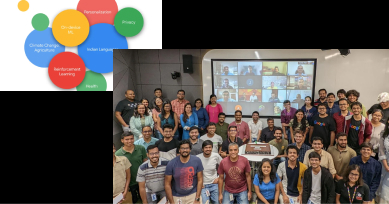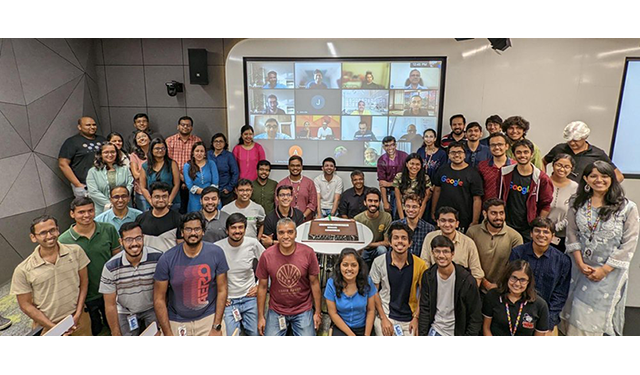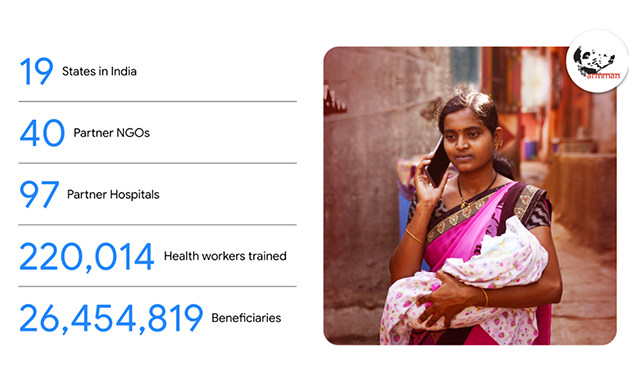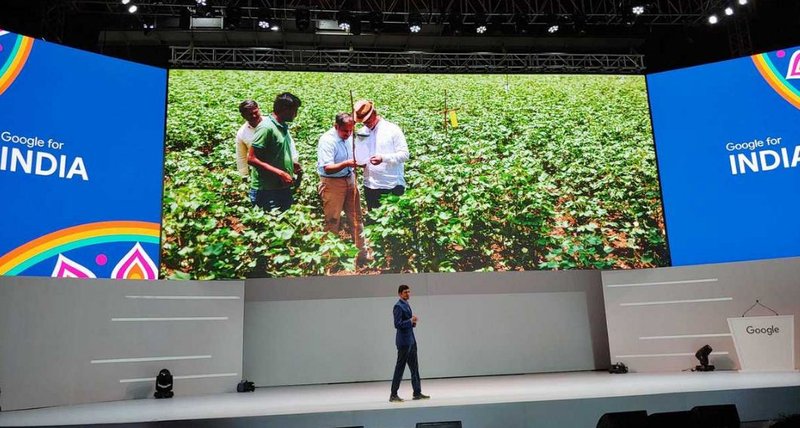India research lab
At India Research Lab, our mission is to contribute towards fundamental advances in computer science and apply our research to tackle big problems and deliver impact for India, Google, and the communities around the world.

At India Research Lab, our mission is to contribute towards fundamental advances in computer science and apply our research to tackle big problems and deliver impact for India, Google, and the communities around the world.
About the team
Our impact and goals for the next 5 years are aligned along three dimensions:
Scientific impact
Advance the state of the art for every problem that we pursue.
- Build models of human cognition and cognition-inspired AI algorithms.
- Understand limitations of deep learning systems, improve their safety and robustness and address issues including calibration, fairness and explainability of ML solutions.
- Combine computer vision based methods with personalised knowledge graphs to better understand images.
- Pursue basic research in HCI, to ensure that our technologies touching end users are informed by an evolved understanding of human factors.
Societal impact
Demonstrate positive societal impact through our research in areas such as health, ecology and wildlife conservation.
- Transform healthcare using ML: Our researchers have developed deep learning based solutions for more effective screening of diabetic retinopathy, which are being deployed at hospitals in India.
- AI for Social Good program to address issues like public health, education and wildlife conservation, in partnership with NGOs and academic researchers, while making fundamental advances to the underlying scientific areas like multi-agent systems, ML and HCI.
- Develop additional novel solutions focussed on the prevention and wellness for major diseases like CVD and diabetes; improve health outcomes at lower costs and solve for the acute shortage of doctors in countries like India.
Product impact
Make significant improvements to Google products to make them more helpful to our users.
- Advance the state of the art and apply ML in areas like natural language understanding (NLU) and user understanding to address the unique challenges in the Indian context (e.g. code mixing in Search, diversity of languages, dialects and accents in Assistant) .
- Enhance overall capabilities (e.g. ability of the Assistant to handle conversations requiring a combination of knowledge, reasoning and personalization), do better user modeling and to improve fraud detection in GPay.
Team focus summaries
The next billion users (NBU) present a unique set of challenges to the search and the advertising business. We aim to solve the research challenges around NBU ads first and extend these solutions broadly to the FBU market as well.
Key technical areas
- Machine Learning
- Natural Language Processing
- Predictive Modeling
Group members
- Aravindan Raghuveer, Engineering Manager (Team Lead)
- Abhirut Gupta, Research Software Engineer
- Anand Brahmbhatt, Pre-doctoral Researcher
- Anirban Laha, Research Software Engineer
- Kushal Chauhan, Research Software Engineer
- Navodita Sharma, Research Software Engineer
- Preksha Nema, Research Scientist
- Rishi Saket, Research Scientist
- Shreyas Havaldar, Pre-doctoral Researcher
- Sneha Mondal, Research Software Engineer
- Soumya Sharma, Pre-doctoral Researcher
- Yukti Makhija, Pre-doctoral Researcher
We build expressive, robust machine learning systems, drawing functional and algorithmic inspiration from human cognition. We are also working to develop a deeper understanding of human cognition, with applications in ML systems design, user modeling, and personalisation.
Key technical areas
- Multi-task and continual learning
- Meta-learning
- Neuro-symbolic architectures
- Interpretability & attribution
- User modeling & personalization
- Computational cognitive modeling
Group members
- Pradeep Shenoy, Research Scientist (Team Lead)
- Jeevesh Juneja, Pre-doctoral Researcher
- Nishant Jain, Pre-doctoral Researcher
- Rishabh Tiwari, Pre-doctoral Researcher
- Shubham Mittal, Pre-doctoral Researcher
- Tarun Verma, Software Engineer
We use machine learning and earth observation imagery to solve geoscience research questions, motivated by applications in climate adaptation and social impact.
Key technical areas
- Computer Vision
- Machine Learning
- Remote Sensing
Group members
- Varun Gulshan, Research Scientist (Team Lead)
- Alex Wilson, Software Engineer
- Vishal Batchu, Research Engineer
Our health research aims to create a mobile platform to collect vital healthcare data in novel ways and use them to predict medical conditions and subsequently suggest behavioral changes as preventive measures.
Key technical areas
- Behaviour Sciences
- Natural Language Processing
- Machine Learning
- Computer Vision
Group members
- Narayan Hegde, Software Engineer (Team Lead)
- Abhimanyu Singh, Product Manager
- Jatin Alla, Pre-doctoral Researcher
- Pradeep Kumar S, Technical Program Manager
- Sriram Lakshminarasimhan, Software Engineer
We conduct fundamental research in ML. The ML algorithms, and deep learning in particular, are effective at optimizing accuracy on a given training-test dataset, but the generalization ability of the algorithms can be very fragile, typically requiring multiple rounds of tuning and iteration for real-world deployment. Our goal is to design robust, rigorous ML algorithms that work (almost) out of the box.
Key technical areas
- Algorithm robustness
- ML optimization
Group members
- Prateek Jain, Research Scientist (Team Lead)
- Aishwarya P S, Software Engineer
- Aniket Das, Pre-doctoral Researcher
- Anirudh GP, Software Engineer
- Arun Suggala, Research Scientist
- Dheeraj Nagaraj, Research Scientist
- Gaurav Srivastava, Software Engineer
- Harshit Varma, Pre-doctoral Researcher
- Karthikeyan Shanmugam, Research Scientist
- Nithi Gupta, Software Engineer
- Pranav Nair, Pre-doctoral Researcher
- Praneeth Netrapalli, Research Scientist
- Ramnath Kumar, Pre-doctoral Researcher
- Soumyabrata Pal, Visiting Researcher
- Varun Yerram, Pre-doctoral Researcher
- Yashas Samaga B L, Pre-doctoral Researcher
We work on fundamental computer vision and machine learning research problems with a focus on creating impact in the areas of healthcare, agriculture and accessibility.
Key technical areas
- Computer vision
- Machine learning
- Graph neural networks
Group members
- Alok Talekar, Software Engineer
- Amandeep Kaur, Pre-doctoral Researcher
- Anirban Santara, Research Software Engineer
- Debapriya Tula, Pre-doctoral Researcher
- Gagan Jain, Pre-doctoral Researcher
- Ishan Deshpande, Research Engineer
- Nidhi Hegde, Pre-doctoral Researcher
- Nikita Saxena, Pre-doctoral Researcher
- Radhika Dua, Pre-doctoral Researcher
- Sharad Shriram, Pre-doctoral Researcher
- Sujoy Paul, Research Scientis
We apply AI methodologies, such as reinforcement learning and multiagent systems, to big problems in public health, education, disaster prevention and conservation, by supporting projects led by social organizations spanning seventeen countries across Asia-Pacific and Sub-Saharan Africa.
Key technical areas
- Public health
- Conservation
- Agriculture
Group members
- Milind Tambe, Principal Scientist (Team Lead)
- Aparna Taneja, Software Engineer
- Arpan Dasgupta, Pre-doctoral Researcher
- Arshika Lalan, Pre-doctoral Researcher
- Divy Thakkar, Program Manager
- Jashn Arora, Pre-doctoral Researcher
- Manish Jain, Software Engineer
We aim to democratize information access and make Google products awesome for Indian language users. At a global level, we aim to make time a horizontal in natural language problems and enable reasoning with it.
Key technical areas
- Multilingual learning
- Representation learning
- Learning from low resources
- Conversational AI
- Knowledge graphs
- Temporal reasoning
Group members
- Partha Talukdar, Research Scientist (Team Lead)
- Bidisha Samanta, Research Engineer
- Dinesh Tewari, Research Program Manager
- Harman Singh, Pre-doctoral Researcher
- Kartikeya Badola, Software Engineer
- Nitish Gupta, Research Scientist
- Palak Jain, Software Engineer
- Rachit Bansal, Pre-doctoral Researcher
- Sagar Gubbi, Visiting Researcher
- Shachi Dave, Software Engineer
- Shikhar Bharadwaj, Pre-doctoral Researcher
- Shikhar Vashishth, Research Scientist
- Siddhesh Pawar, Pre-doctoral Researcher
- Sriram (Sri) Ganapathy, Visiting Faculty Researcher
Featured publications
Highlighted work
-
 Google for India 2022: Driving impact with AI across Indian languages, the agricultural ecosystem, aGoogle Research’s journey in India in the last three years, along with our partners, has been exciting and rewarding, from finding solutions for Indian language speakers to enabling better maternal healthcare solutions and helping to efficiently diagnose preventable diabetic blindness. Solving Indian challenges means solving for areas as diverse as our country of over a billion people. We share how AI and ML deliver meaningful and scaled solutions in Language, Agriculture, and Health.
Google for India 2022: Driving impact with AI across Indian languages, the agricultural ecosystem, aGoogle Research’s journey in India in the last three years, along with our partners, has been exciting and rewarding, from finding solutions for Indian language speakers to enabling better maternal healthcare solutions and helping to efficiently diagnose preventable diabetic blindness. Solving Indian challenges means solving for areas as diverse as our country of over a billion people. We share how AI and ML deliver meaningful and scaled solutions in Language, Agriculture, and Health. -
 A Glance at Past Three Years of Google Research in IndiaGoogle Research India was founded with two key principles: (1) to advance fundamental computer science and AI research by building a strong team while partnering with India’s research community and (2) to apply that research to some of the country’s biggest healthcare, agriculture and education problems while continuing to develop services that benefit people everywhere. The journey has been deeply fulfilling, from working with local NGOs as they use AI approaches, scaling the impact of their efforts, to developing and sharing multilingual language models that better understand Indian languages than ever before.
A Glance at Past Three Years of Google Research in IndiaGoogle Research India was founded with two key principles: (1) to advance fundamental computer science and AI research by building a strong team while partnering with India’s research community and (2) to apply that research to some of the country’s biggest healthcare, agriculture and education problems while continuing to develop services that benefit people everywhere. The journey has been deeply fulfilling, from working with local NGOs as they use AI approaches, scaling the impact of their efforts, to developing and sharing multilingual language models that better understand Indian languages than ever before. -
 Using ML to Boost Engagement with a Maternal and Child Health Program in IndiaIn a recent 23,000-participant study, we demonstrate how #MachineLearning can achieve ~30% improved engagement with an automated voice messaging program for maternal and child health in India, operated by our partners @armmanindia.
Using ML to Boost Engagement with a Maternal and Child Health Program in IndiaIn a recent 23,000-participant study, we demonstrate how #MachineLearning can achieve ~30% improved engagement with an automated voice messaging program for maternal and child health in India, operated by our partners @armmanindia. -
 Google Research India: an AI lab in BangaloreAnnouncing the launch of Google Research India - an AI Lab focused on advancing fundamental computer science and AI research, and applying it to tackle big problems in the field of healthcare, agriculture and education.
Google Research India: an AI lab in BangaloreAnnouncing the launch of Google Research India - an AI Lab focused on advancing fundamental computer science and AI research, and applying it to tackle big problems in the field of healthcare, agriculture and education.
Some of our locations
Some of our people
-

Manish Gupta
- Distributed Systems and Parallel Computing
- Education Innovation
- Machine Intelligence
-

Aravindan Raghuveer
- Information Retrieval and the Web
- Machine Intelligence
- Natural Language Processing
-

Abhirut Gupta
- Machine Translation
- Natural Language Processing
-

Milind Tambe
- Machine Intelligence
-

Alok Talekar
- Data Management
- General Science
- Machine Intelligence
-

Divy Thakkar
- Education Innovation
- Human-Computer Interaction and Visualization
-

Pradeep Shenoy
- Data Mining and Modeling
- Machine Intelligence
- Machine Perception
-

Varun Gulshan
- General Science
- Machine Intelligence
- Machine Perception
-

Aparna Taneja
- General Science
- Machine Intelligence
- Machine Perception
-

Vishal Batchu
- Machine Learning
- Machine Perception
- Software Engineering
-

Narayan Hegde
- General Science
- Human-Computer Interaction and Visualization
- Machine Intelligence
-

Prateek Jain
- Algorithms and Theory
- Machine Intelligence
-

Anirban Santara
- Machine Intelligence
- Robotics
-

Sujoy Paul
- Machine Intelligence
- Machine Perception
- Robotics
-

Partha Talukdar
- Machine Intelligence
- Natural Language Processing
-

Shachi Dave
- Data Mining and Modeling
- Machine Translation
- Natural Language Processing
-

Preksha Nema
- Natural Language Processing
-

Praneeth Netrapalli
- Algorithms and Theory
- Machine Intelligence
- Machine Perception
-

Rishi Saket
- Algorithms and Theory
- Information Retrieval and the Web
- Machine Intelligence
-

Sriram Lakshminarasimhan
- Data Management
- Data Mining and Modeling
- Distributed Systems and Parallel Computing
-

Kushal Chauhan
- Machine Intelligence
- Machine Perception
- Natural Language Processing
-

Gargi Singh
- General Science
- Machine Intelligence
- Machine Perception

